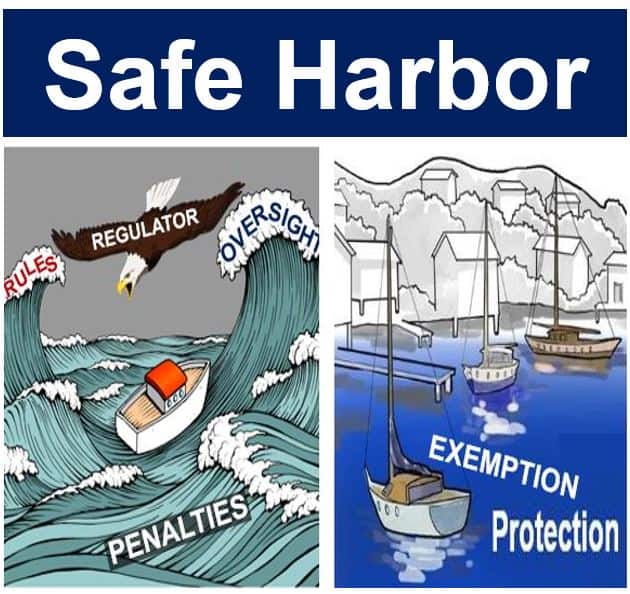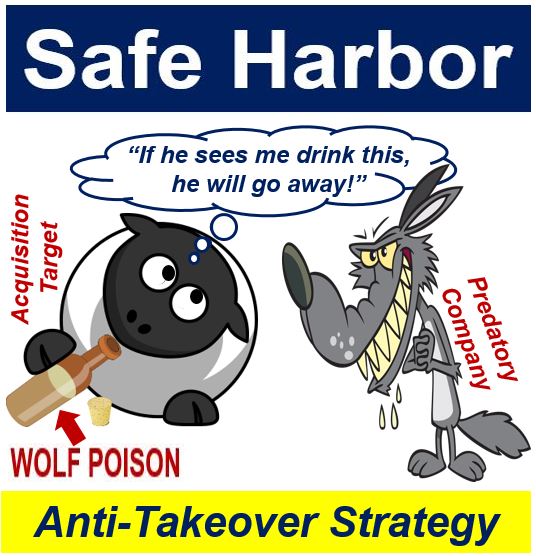What is safe harbor? Definition and meaning
A safe harbour is a provision in a law, regulation or agreement that affords protection from penalty, liability or oversight under certain circumstances, or if specified conditions are met by the entity. It is a type of protection from the rough seas and choppy waters of rules and regulations.
Spelling: USA – harbor. UK/Ireland/Australasia: harbour.
Many regulations and laws include a safe harbor clause that specifies the circumstances in which otherwise regulated individuals, companies or other entities can do something without regulatory interference or oversight.
Safe harbor may also refer to an anti-hostile takeover defense in which the firm that is being targeted for acquisition purchases a very heavily-regulated company, thus making itself less attractive for the predatory company.

It is the opposite of unsafe harbor, which describes a conduct that will be deemed to be in breach of a rule or regulation.
The term safe harbor is used the real estate, legal and finance industries in several different ways.
According to Cornell University Law School’s Legal Information Institute, safe harbor is:
“A provision granting protection from liability or penalty if certain conditions are met.”
“A safe harbor provision may be included in statutes or regulations to give peace of mind to good-faith actors who might otherwise violate the law on technicalities beyond their reasonable control.”
Safe harbor in driving regulations
Regarding a statute that requires vehicle drivers to ‘not drive recklessly’, a clause specifying that if you drive slower than 25 mph (40 km/h) you will be conclusively deemed not to be driving recklessly, is an example of a safe harbor.

Similarly, a clause in a driving regulation that states that if you drive faster than 90 mph (145 km/h) you will be conclusively deemed to be driving recklessly, is an example of an unsafe harbor.
In this traffic regulation example, if you drive your car faster than 25 mph and slower than 90 mph, your action will fall outside either a safe or unsafe harbor – and you will be judged according to the ‘reckless’ standard.
Safe harbor in real estate
A new state law says that all landowners have to measure and report the size of their property.
Spot-checks will be conducted by state county inspectors to detect any discrepancies.
Landowners who under-report land may face a fine of $500 per unreported acre.
However, this new law also has a safe harbor clause. If you relied in good faith on a third-party surveyor or a faulty measuring tool, you will not be assessed a fine. This example came from Cornell’s Legal Information Institute.
Safe Harbor Framework – EU/USA
The international Safe Harbor Privacy Principles, also called the Safe Harbor Privacy Principles or Safe Harbor Framework (Framework), were principles which the European Court of Justice overturned in October 2015.
The Framework enabled some American companies to comply with privacy laws protecting Swiss and European Union (EU) citizens.
American firms storing costumer data would self-certify that they complied to seven principles, an EU and Swiss requirement.
The Europe Union, together with the US Department of Commerce and the Federal Data Protection and Information Commissioner of Switzerland, developed privacy frameworks.
In the year 2000, the European Commission had made a decision that the United States’ principles complied with the EU Directive – the Safe Harbor Decision.
However, after a customer complained that his personal Facebook data were not sufficiently protected, the European Court of Justice declared that the Safe Harbor Decision was invalid. This led to further talks between the European Commission and US authorities towards a ‘a renewed and sound framework for transatlantic data flows’.
In July 2016, the EU-US Privacy Shield was announced – a replacement for the Safe Harbor Framework.
According to the European Commission:
“The EU-U.S. Privacy Shield imposes stronger obligations on U.S. companies to protect Europeans’ personal data. It reflects the requirements of the European Court of Justice, which ruled the previous Safe Harbor framework invalid.”
“The Privacy Shield requires the U.S. to monitor and enforce more robustly, and cooperate more with European Data Protection Authorities.”
The EU-US Privacy Shield includes, for the first time, written assurance and commitments regarding access to data by public authorities.
According to the Information Technology Industry Council (ITIC), the EU-US Privacy Shield contains three key features: “1. Strong Obligations for Companies’ Handling of EU Citizens’ Data. 2. Clear Safeguards and Transparency Obligations for U.S. Government Agency Access. 3. New Redress and Complaint Resolution Mechanisms for EU Citizens.”
Put simply, the Safe Harbor framework was an agreement between the EU and the USA. It was a mechanism under which over 4,400 commercial enterprises of all sizes, from within every industry, legally transferred data from the EU + Switzerland to the USA. Thanks to that framework, the transatlantic trade relationship thrived. In October, 2015, it became invalid. Now we have the EU-US Privacy Shield.

